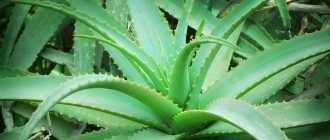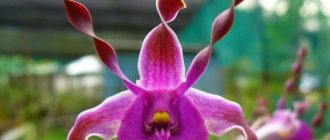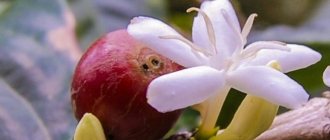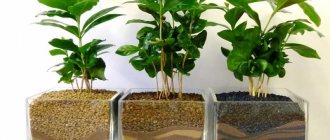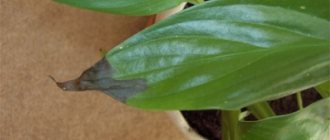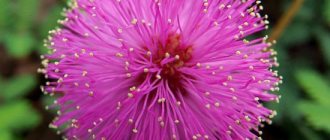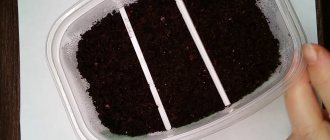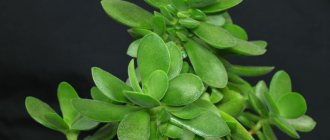What soil is needed for an Arabica coffee tree? Conditions and care
How to care for a coffee tree.
Like any southern tree, coffee prefers soft but bright diffused light (not direct sunlight!), room temperature 18-22°C and regular ventilation (not drafts!) with warm air. The soil for the coffee tree is heavy and acidic (pH no more than 5.5). You can prepare it yourself by taking leaf soil, greenhouse soil, and sand in a ratio of 1:1:1:2:1, or purchase ready-made PETER PEAT soil with an acidic reaction “Azalea. Hydrangea. Rhododendron" line HOBBY. The presence of chopped sphagnum moss in the soil (for example, “Sphagnum Moss” from the VITA line) will not hurt: it will maintain its acidity and perfectly retain moisture. The root system of the coffee tree is extensive and deep, so you will need a large and high planting container, as well as drainage from expanded clay from the VITA line or pebbles from the DECO line.
Watering
Water the tree only with settled, soft and slightly warmed water. From March to October, when the tree is actively growing and blooming, provide it with abundant watering, making sure that water does not accumulate in the pan and the roots do not rot. From November to February, the coffee tree is dormant and can be watered only after the surface layer of soil has dried.
Feed your pet with liquid humic fertilizer PETER PEAT “Living Force: for indoor plants” from April to September once every 2 weeks. When caring for it, do not “circle” or rearrange it, trying to achieve uniform illumination - the tree will shed its leaves and stop blooming. Transplantation and a new pot will be required annually (March-April), until the coffee tree reaches three years, and then every 2 years.
Trimming
The plant should be pruned as needed. Remove leaves and stems if they dry out. Form the crown by cutting off overgrown branches and giving them the required length.
Coffee tree benefits at home. Care after purchase
So, how to grow Arabica coffee at home? The coffee tree is famous for its unpretentiousness, but this does not mean that it does not need care and the creation of the necessary conditions.
REFERENCE! The first thing you should think about before purchasing is whether your apartment has the space needed for the tree. The fact is that Arabica can grow to the size of a two-meter bush.
Position the plant so that the sun's rays do not directly hit the leaves. Contact with sunlight can cause burns on tender leaves. At the same time, Arabica loves bright lighting, preferably a little diffused.
If there is a lack of natural light, you can install phytolamps. This will create additional lighting. Coffee will feel most comfortable on windows facing east or west.
ATTENTION! Arabica is native to the tropical lands of Asia and Africa. This is where this species grows wild.
The climate in Russia is unsuitable for coffee, so attempts to create a plantation on your own estate will not achieve the expected result. Arabica will not survive the cold season.
Watering
Arabica has an active period and a period when the plant goes dormant.
The active period occurs in the warm part of the year, from approximately March to October. At this time, Arabica needs the soil to constantly maintain moisture and not dry out. During hibernation, water consumption decreases.
It is better to pre-settle water for irrigation or use filtered purified water.
REFERENCE! In an effort to maintain soil moisture, you cannot overdo it and create an artificial swamp. If you overdo it with moisture, there is a danger of rotting of the root system.
Feeding should be done during the active period. Fertilizer should be added to the water for irrigation once a week.
ATTENTION! The fertilizer should not contain calcium.
During the cold season, a period of rest begins. During this period, watering should be reduced. It should also be taken into account that in winter evaporation occurs with less intensity than in summer.
REFERENCE! In addition to watering, Arabica requires constant spraying. Air humidity in the room is of great importance for the plant.
It is especially important to spray leaves during the heating season, when the air in apartments becomes especially dry.
Bloom
Coffee blooms in a delicate white color. The thin petals of the Arabica coffee flower exude a rich, pleasant aroma. As a rule, the flowering of the Arabica coffee tree begins in the third or even fourth year of life.
Subsequently, the flowers give way to small round red fruits. If, upon reaching the specified period, flowers do not appear on the tree, then you need to check whether the plant is being cared for correctly.
ATTENTION! Proper lighting is important for the coffee tree to bloom. The reason for the lack of flowers may be a lack of light.
Below are photos of Arabica coffee; caring for it at home allows you to achieve the following results:
Priming
For Arabica, slightly acidic soil is most suitable. If it is not possible to purchase a ready-made soil mixture for a coffee tree, you can use mixtures for plants that also prefer acidic and slightly acidic soil. These plants include azalea or hydrangea.
REFERENCE! Before planting your coffee tree, make sure the pot you choose is the right size. A thick drainage layer should be placed on the bottom.
This is a prerequisite for all plants that require abundant watering. If the drainage layer is sufficient, then water will not linger near the roots and will not create a risk of rotting.
Soil for coffee trees at home. Preparing the soil for cultivation
Coffee loves acidic soils, which corresponds to the conditions of its homeland. The pH level for coffee should be between 4.5 and 5.5. At the same time, some gardeners recommend using soils for azaleas, hydrangeas or rhododendrons for coffee trees at home. However, you should pay attention to the acidity level.
If it is slightly higher than recommended (for example, soil pH for azaleas is 4.0), it can be used to grow a coffee tree, but if the soil is highly acidic (pH = 3.5), then it is better not to do this.
Fruiting coffee tree (Arabica), grown at home
Sometimes inexperienced gardeners purchase soil suitable for growing citrus fruits for a coffee tree. It is only partially suitable for the coffee tree, since its composition is acceptable, but it is more neutral than slightly acidic. You also need to know that approximately six months to a year after the start of active growing season, the soil under the coffee tree changes its composition and ceases to be acidic, shifting to neutral acidity.
In both of the considered cases, to ensure a normal acidity level for coffee, it is recommended to “acidify” the soil once a month. This is best done with lemon juice in a concentration of 3-4 drops per 1 liter of water. If you don’t have lemon on hand, you can use citric acid (2-3 grains per 1 liter of water).
The roots of the coffee tree are quite long, penetrating deeply into the soil. To ensure they have adequate supply of nutrients and air, it is necessary to use well-drained and loose compounds. The matted soil must be loosened and humus or peat added to it (depending on the acidity).
You can prepare the soil yourself. For this you will need:
- turf soil – 1 part
- leaf soil - 1 part
- humus - 1 part
- coarse river sand – 1 part
- peat – 2 parts
Sometimes it is recommended to add 0.5 parts of sphagnum moss to this composition for greater looseness.
Care instructions
Growing coffee will require the organization of certain conditions. However, the effort expended will be more than repaid due to the decorativeness of the bush. First of all, coffee is a solitary tree; it does not tolerate other plants around it. Therefore, you need to either allocate a separate window sill for it, or place a single cabinet for the plant not far from the window. At the same time, the flower does not like frequent movements, so the place should be permanent. And it’s better if there is a lot of free space around. In addition, the plant should not be rotated, especially during flowering, as the buds may fall off.
Arabica coffee at home
Arabica coffee at home, as well as in natural conditions, is very demanding of light. It is best if it is bright but diffuse lighting without direct sunlight. South and east windows are ideal.
In the warm season, coffee trees also do well outdoors - on the balcony, in the summer cottage. However, you need to provide them with light shelter from the sun so that ultraviolet rays do not burn the crown.
In winter, the plant needs additional lighting with halogen or fluorescent lamps.
If the lighting in the apartment is weak, then the coffee tree may not bloom or bear fruit.
Temperature is also very important. Since coffee comes from the tropics, it does not tolerate cold weather. The minimum temperature in the room should not be below 20°C, especially in winter. The optimal temperature is +22…+24ºC. In winter, it is better to keep the plant away from heating sources to avoid drying out and falling leaves.
Bloom
The coffee tree loves fresh air, so it is advisable to ventilate the room more often.
To successfully care for coffee, it is important to water the tree correctly. It is very demanding of moisture, especially during the period of growth, flowering and fruit formation:
- You can’t water a flower with tap water; it needs to sit for at least 1-2 days;
- the plant does not like lime, this also needs to be taken into account when watering;
- moisten the soil in the pot only with water at room temperature or 2-3ºC higher - both in winter and summer;
- If there is liquid left in the pan after watering, it must be removed.
The earth ball in the pot should always remain moist. The amount of water is increased in proportion to the increase in temperature in the room. Water regularly, but make sure that the water does not stagnate. The soil should never be allowed to dry out completely.
In winter, watering is reduced, but care is taken to ensure that the tree does not lack water.
Indoor coffee loves to be sprayed with warm water. Moreover, this can be done daily, especially in the warm season. It is better to spray in the morning or evening. In winter, the plant does not need this procedure, but if the foliage is dusty, you can wipe the leaves with a damp sponge.
Mineral supplements have a beneficial effect. They usually begin at the beginning of the growing season - in the spring - and are carried out until the flower bears fruit. It is recommended to fertilize 2 times a month with complex mineral fertilizer. You can feed with nitrogen and potassium salts at the rate of 3 g of potassium salt and 5 g of ammonium nitrate per 1 liter of water. The optimal rate for an adult plant is 1 liter per feeding time. You can combine mineral salts with organic matter (slurry), but the result must be observed. With the onset of autumn, feeding is stopped.
What soil is needed for a coffee tree? Where can I get a coffee tree seedling?
The first option is that a coffee tree can be grown from a grain (seed). Yes, in fact, coffee beans can be grown, but not from what is sold in stores. It is impossible to grow a coffee tree from the coffee beans we are used to, even if they are not roasted. To do this, you need to purchase special coffee tree seeds, these are sold in specialized garden stores. But when growing coffee from seeds, you will have to wait a very long time for the first flowering and fruiting.
The best option would be to purchase a rooted cutting from a coffee tree. Coffee cuttings are not expensive and fruiting can be achieved after only a year of cultivation. You can buy rooted coffee cuttings in nurseries (exotic plant stores) or from amateur collectors (such sales advertisements are usually posted on social networks and forums); when buying a plant on free classifieds sites (Ebay, Avito, OLX), they can very often deceive and sell the wrong thing, it is better to refrain from such purchases.
We bought a coffee tree seedling – what to do?
You bought a small coffee tree seedling, brought it home, and what to do next? The first step is to transplant the seedling from the shipping container into a permanent pot. Usually, during mass propagation and cultivation, inexpensive, square containers are used, which are filled with special soil to accelerate the growth of the plant’s root system. Such pots and soil are great for greenhouses, but are completely unsuitable for apartment window sills, they are not beautiful, and the soil in such pots dries out very quickly, which can lead to the death of the coffee tree. That's why a transplant is necessary.
Arabica coffee soil. Special soil for coffee tree
Coffee trees are very heat-loving plants. This is why ordinary soil is not at all suitable for a coffee tree. Growing a coffee tree at home is not at all difficult. The most important thing is to be patient.
The coffee tree begins to bear fruit in the third year, and the maximum yield is obtained after six to seven years.
Growing a tree from grain
An exotic plant like a coffee tree can be grown in two ways. The first of them is cuttings. If you have the opportunity to buy or get a cutting of such a wonderful plant somewhere, it is best to use this method. The fact is that the cutting will grow much faster than the shoot from the grain. And they develop fully, in breadth (in a bush), while the grain can stretch into a long bare (without leaves) stem.
The most suitable varieties for growing indoors are Arabian (arabika) and dwarf Nana (dad).
However, growing a coffee tree at home from a grain is much more interesting. There is nothing tricky or complicated in this process. Even regular unroasted coffee beans bought in a store are suitable for growing. Before putting a coffee bean into the ground, it is necessary to carry out pre-planting preparation. In order for the grain to germinate accurately, the hard outer shell must be slightly disturbed (sawed, broken or cut). Such delicate work may require some experience, but you can do without it. It is also necessary to soak the grains in a solution of stimulants, for example, Heteroauxin or Epin.
Return to contents
Ground and air
Planting coffee is not at all difficult, but the soil for such an outlandish plant must be special. The soil for growing coffee at home must be acidic, otherwise the grain will not be able to germinate. Of course, a beginner, and sometimes even a fairly experienced gardener, cannot accurately determine the acidity of the soil, which is why it is best to make your own composition:
The optimal temperature for growing a coffee tree at home is 22-25°.
- 20% river sand;
- 40% turf land;
- 30% leaf soil;
- 10% high peat.
Arabica trees grow just perfectly in such soil. However, in addition to the soil, special attention should be paid to air humidity.
It must be maintained, and standard spraying is not always enough. To solve this problem, you need to place the pot with the plant on a tray with small pebbles or expanded clay and pour water into it.
But even after this, the plant should be sprayed periodically.
Return to contents
Required lighting
Proper lighting for exotic plants is no less important than good soil. Of course, this plant does not make any special requirements. It loves light and warmth, but at the same time, excess sunlight can have a detrimental effect on the development of the sprout.
The most common mistake when growing a coffee tree is exposing the plant to direct sunlight.
The ideal place to place a pot with a coffee sprout would be the southeast or southwest. On the north side, coffee will also grow, but due to the lack of warm sunlight, its formation will be slower.
As mentioned above, excess sun can be harmful, but this applies mostly to young, not yet fully formed plants. In order for the coffee sprout to be healthy and develop well, it should not be exposed to direct sunlight.
As for adult plants, they simply need the sun to form inflorescences.
Return to contents
Transplanting and watering
In order for a coffee tree to grow and develop, it, like other house plants, must be replanted periodically. Young coffee cuttings are replanted every year. But adult fruit-bearing plants can be replanted no more than once every three to four years.
Water the plant with soft, settled water.
Before replanting begins, drainage must be placed at the bottom of the new pot. In addition, you should carefully examine the root system, removing diseased or rotten roots.
As for watering, it should be plentiful in the summer, but moderate in the winter. In order to correctly calculate the frequency of irrigation, it is necessary to take into account the temperature in the room where the coffee is grown. The soil for the coffee tree should always remain moist. In this case, you should avoid overmoistening and, of course, overdrying. It is better to water and spray a young coffee tree with soft water. Melt and rain liquid are most suitable for these purposes.
Some people believe that since coffee comes from the tropics, it needs the rays of the scorching sun all year round. This conclusion is fundamentally incorrect. Even on huge plantations in the tropics, other plants are planted around one coffee seedling for shading. Therefore, even in our conditions, it is impossible to leave a coffee sprout in open sunlight for a long time.
In cold weather, such exotic plants should be kept warm at a temperature of at least 18°C.
So that the plant does not need sunlight in winter, it must be illuminated with a fluorescent lamp.
Do I need to graft a coffee tree? Planting a coffee tree
To plant a tree that will bear fruit in the future, you need to take this process as seriously as possible.
There are 2 methods of planting it:
- Grain;
- With a cutting.
How to plant a coffee tree using beans or seeds?
You can buy coffee beans in a store, or you can get them from friends or relatives. Just don’t confuse it with roasted coffee beans. The method of planting using grain is the most difficult. Although not much different from planting a lemon or pomegranate. But there are distinctive features. The reason for the difficulty when planting coffee seeds is its structure, namely a very hard and durable shell. Its rigidity often interferes with seed germination.
In this regard, before planting a seed in the ground, it is necessary to scarify it. What is scarification? This is the destruction of the seed shell.
It can be carried out using two methods:
- Chemical (solution of sulfuric or hydrochloric acid);
- Mechanical (incision or filing of the seed);
After this procedure, it is important to soak the grain in one of the stimulating solutions such as “Zircon”, “Kornevin” or some other. It is important to plant the grain in soil that is soft enough. It cannot be buried deeply; it is enough to simply lay them on the ground without sprinkling soil on top. Plant the seeds at a short distance from each other, if there are several of them - about 4 cm. Plant the grain in the ground with its flat side down, and its convex side up, respectively.
How to plant a coffee tree using cuttings?
Coffee tree cuttings
If you manage to get a cutting of a coffee crop somewhere, then that’s just great. In this case, it will begin to bear fruit much faster. It will be possible to collect the first fruits already in the first year of growth of this crop.
Since the cuttings retain all the properties of the mother plants, they will produce large fruits and in large quantities. However, the growth of the tree itself is slower than when planted as a seed.
In addition, the coffee will not grow in height, as if it were planted as a grain, but in width. It is very easy to plant; there are no differences from planting other crops using cuttings.
What soil for a coffee tree. Soil/soil for coffee tree
What kind of land is needed for coffee? (compound)
The coffee tree grows on soils with a slightly acidic pH of 5-5.5.
The following soil composition has proven itself well:
- Turf land - 40%;
- Leaf soil - 30%;
- Sand - 20%;
- Peat - 10%.
For seedlings up to 4 years old, the following soil composition may still be suitable: turf soil, sand, leaf soil in a ratio of 1:1:2. Such plants are replanted once a year.
For adult plants (5 - 10 years old), they also take turf soil, humus, leaf soil, sand in a ratio of 2: 1: 3: 0.5. This soil mixture is also suitable for older plants. They are replanted once every 3-5 years.
It is recommended to add sphagnum moss to the soil mixture. It will enrich the soil very well, provide it with acidity and maintain moisture.
In the photo below you will see what the components that make up the mixture look like:
Sod land
Leaf ground
Peat land
Method of preparing the mixture
The soil mixture should be prepared in advance. Experienced gardeners prepare the soil 2 weeks before transplanting so that it can settle. Disinfection by steaming or piercing in the oven is recommended.
If it is not possible to make a similar soil composition, then choose any Universal soil. A soil mixture for azaleas is even better; it also has an acidity pH of 4.5-5.5.
To it you need to add 25% sand and a little coal chips. To do this, you can use several tablets of activated carbon.
There is information that a young cutting of a coffee tree grows very well in a mixture of peat and perlite (this is a type of construction sand) in a 1:1 ratio. When planting, this mixture should be treated with a weak solution of potassium permanganate.
Attention! When planting, do not compact the soil! The soil should be light, loose, soft and not dry.
Enrichment of soil with mineral fertilizers
During the active growing season (spring - summer), feeding is carried out 2 times a month with diluted fertilizer from mullein or chicken manure.
Also, once a month the soil is fertilized with mineral fertilizers. The most suitable fertilizer for flowering plants or roses.
Therefore, 2 - 3 times a month, the water for irrigation needs to be acidified (2 - 3 drops of lemon juice per 1 liter of water).
It is very important to remember about drainage in order to prevent excess moisture in the soil.
It is important to know that with a neutral or alkaline soil reaction, the absorption of nutrients by the plant slows down. The development of the tree will be delayed, the leaves may turn black (necrosis will occur), and the tree will not bloom.
Soil for azaleas. Soil for indoor azaleas
Indoor azalea is also a fan of acidic soil. When choosing a ready-made substrate in a specialized store, you should pay attention to several things: first of all, the acidity should not go beyond 3.5-5.5, the soil should not be old and should be suitable for the plant that will be planted. What is meant in the last paragraph: the chemical composition of the substrate can be different, so some soils are better suited for planting adult plants in them, while others are better suited for sowing seeds or planting young plants.
One of the mandatory components of soil for azaleas is coniferous soil; if its content is not indicated in the composition, it is worth purchasing it additionally.
When familiarizing yourself with the composition of the finished soil, you should also check whether any specific mineral fertilizers are included in it. They are usually present in the soil and last for the first two months, so fertilizing immediately after planting is not needed. If this is not checked and the already nutritious soil is fed, the sensitive azalea can quickly die; excess minerals are destructive.
If you wish, you can prepare the soil mixture yourself. For this you will need leaf, heather, coniferous soil and peat. In order to increase the acidity level, you can add crushed pine bark. Coniferous soil is a must!
To disinfect the soil, you can add washed, dried and crushed sphagnum moss or charcoal.
Perlite or river sand, or both, will help loosen the soil and improve air access to the roots. Well, drainage, expanded clay is used as it and is poured onto the bottom of the pot, in a layer of about 3 centimeters.
Azalea reacts negatively to lack of watering, so if there is the prospect of long trips or an unstable schedule, it is worth adding hydrogel granules to the soil. It will retain moisture and gradually release it to the soil.
What kind of pot is needed for a coffee tree. Temperature and Lighting for Growing Coffee Trees
Coffee is a southern resident, but direct sunlight is contraindicated for it. Otherwise, the beautiful shiny leaves may suffer, their edges will dry out and the plant will lose its decorative effect. The following conditions are considered optimal: Abundant diffused lighting (eastern or western window). When placed on the south, southeast or southwest side, shading is required during the midday hours in summer and early spring. Fresh air and regular ventilation. No drafts - air flows during ventilation should not hit the coffee tree. Keep in the spring-summer period at a temperature of 22-26°C. Temperature drop in winter to 16-18°C.
Temperatures below 15°C will cause the plant to shed buds and leaves, and air colder than 12°C can be detrimental to the tree. During the heating season, the flower pot should not be located near heating devices. The coffee tree can be located on the north side, but in this case the growth process will be delayed, and it will not be possible to wait for flowering, especially beans, without sufficient sunlight.
Soil for coffee tree. Types of coffee trees
The Arabian coffee variety, popular for growing at home, is a compact tree. The leaves are shaped like an elongated ellipse with a dark olive tint, glossy on the outside and pale on the inside. The inflorescences are small, about 2 centimeters in diameter, collected in a bouquet. The size of the inflorescences directly depends on the growing conditions.
Once opened, flowers remain fresh for only a few hours. But the buds gradually open, not all at once. After the inflorescences fade, the fruit ripens in the form of a berry; when ripe it has a burgundy hue. Ripening occurs approximately 8 months after pollination. The paired fruits resemble round beans. This species reaches a height of up to 5 meters.
Coffee dwarf Nana is a neat plant, reaching a height of about 85 cm. It blooms profusely and subsequently bears fruit well at home. The tree can be given the desired design by trimming and pinching the tops of the plant.
Liberian coffee is also grown indoors. Its ripe fruits have a scarlet or sunny slightly orange tint. The length of its leaves reaches up to 40 cm, and the height is adjusted and the required shape is formed by trimming the crown of the plant. The inflorescence has a light shade and large fruits - berries.
Reproduction and transplantation
At home, Arabica coffee is propagated by seeds and cuttings. It is believed that the first method is more productive, since shoots taken from an adult plant are prone to poor root formation. Experts say that reproduction can be done at any time of the year.
Coffee fruits and seeds
The main feature of propagation by seeds is that they must be of exceptional freshness. It is believed that seeds that have just been picked from the tree have the greatest germination rate. They are immediately planted in the ground. The maximum shelf life for seed material is 1 year. Every year the germination rate gets worse.
Coffee seeds are green coffee beans. They can be purchased at the store or picked from a fruit-bearing tree. Each seed has a very dense skin, which makes germination difficult. To speed up the emergence of seedlings, grains can be:
- soak in a very weak solution of acetic acid for 24 hours;
- lightly cut the peel around the perimeter with a sharp knife;
- Lightly tap the seed with a hammer so that the skin bursts a little.
After these procedures, it is imperative to soak the seeds in a stimulating solution, for example Heteroauxin.
Sowing is done in small containers filled with a nutrient mixture. Coffee prefers acidic soils rich in humus. The soil for sowing consists of light turf soil - 1 part, leaf soil - 0.5 parts and coarse river sand - 1 part. Each seed is immersed in the substrate to a depth of no more than 2 cm. The soil is moistened and covered with glass or film. The soil temperature for germination must be at least 20ºC. It is better to keep such greenhouses on the sunny side of the window, and provide additional lighting in winter. Crops are periodically moistened and ventilated. With proper care, young coffee sprouts should emerge within a month.
As soon as the plants get stronger, they are planted in pots with a diameter of 5-7 cm with the same soil composition. This usually happens 10-12 months after seedlings appear. As soon as the roots of young trees are well entwined with an earthen ball, they need to be transferred into permanent pots with the composition of the earthen mixture: turf, leaf, sand in a ratio of 1:1:1. It is allowed to use a mixture for azaleas.
Coffee tree cuttings
Propagation by cuttings has its own characteristics. Cuttings 10-15 cm long are cut from an adult plant obliquely. In this case, each one must have at least 2 internodes. The distance to the lower bud is 2 cm. Leaves on cuttings are shortened by half to avoid moisture loss.
The cuttings are placed in a nutrient substrate consisting of peat and coarse river sand. It is better to bake it for 1 hour in the oven to destroy bacteria and pests. Each shoot is buried 1-1.5 cm into the soil, the soil is lightly compacted, watered and covered with a glass jar or film to create greenhouse conditions. The temperature in such a container should not be lower than +25…+27ºC.
Greenhouses should be periodically ventilated and moistened. Root formation usually occurs within 4-5 weeks. As soon as new shoots appear on the plants, we can assume that the tree has taken root. After the development of 3-4 young leaves, the plants are transplanted into permanent pots with standard soil and placed in a permanent place.
Interestingly, after propagation by cuttings, coffee can bloom in the first year. However, these buds should be removed, as they weaken the bush and will interfere with the proper development of the crown.
Transfer
Young plants are replanted every year, 3-4 year old plants - once every 2 years, and tubs - as needed. Pots need to be tall because coffee has a deep central root. Be sure to take care of good drainage - pour a layer of expanded clay or broken brick on the bottom of the container. Add 1 part of humus to the standard composition of the substrate.
Transplanting a plant
When replanting, it is better not to disturb the root structure, but to transfer the lump completely, adding soil to the sides and top, lightly compacting it.
If it is not possible to replant the plant completely, you need to remove a few centimeters of the top layer of soil and add soil.
Experts advise replanting before the beginning of the growing season - in early spring.
Specifics of growing a coffee tree
The coffee tree grows very quickly and, with proper care, can reach a height of 1.2-1.5 m in 2-3 years. This is the barrier for the plant when it begins to bloom and bear fruit. It is important to wait patiently for this particular period, carefully caring for the tree. To form a crown, young shoots can be pinched and dry shoots can be removed immediately. If grown correctly, a few years after planting, you will not only be able to admire the lush crown and flowers, but also collect up to 0.5 kg of aromatic grains per year.

